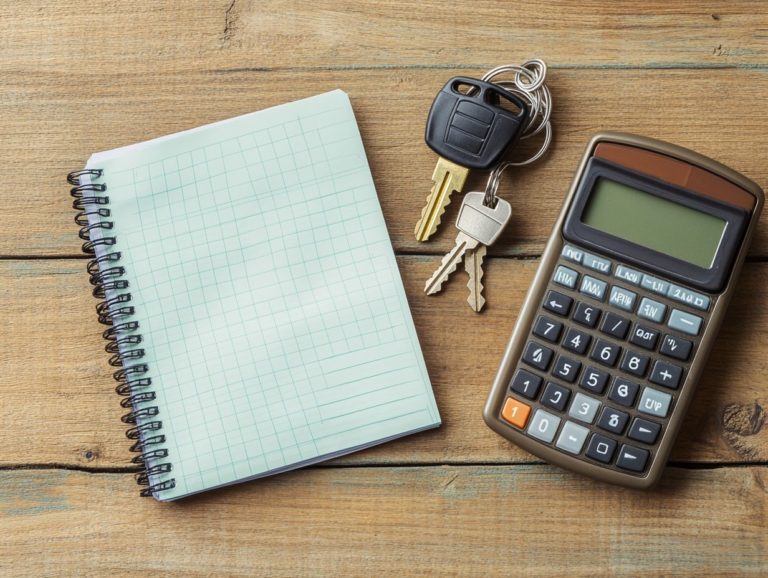How to Transfer Your Car Lease: A Step-by-Step Guide
Car leasing offers an appealing alternative for those who enjoy the thrill of driving a new vehicle without the long-term commitment of ownership.
However, life can be unpredictable, and circumstances may shift, prompting the need to transfer your lease. Whether you re downsizing, relocating, or simply craving a different ride, understanding car lease transfers is crucial.
This guide will help you discover different types of leases and how to handle them effortlessly. We will also highlight key considerations to keep in mind throughout this journey.
Immerse yourself in this content to confidently navigate your lease transfer!
Contents
- Key Takeaways:
- Understanding Car Leases
- Why Transfer Your Car Lease?
- Step-by-Step Guide to Transferring Your Car Lease
- Important Considerations for Car Lease Transfers
- Frequently Asked Questions
- 1. What is a car lease transfer and why would I need to do it?
- 2. How do I know if I am eligible to transfer my car lease?
- 3. How do I find someone to take over my car lease?
- 4. What documents do I need for a car lease transfer?
- 5. Can I transfer my car lease if I still owe money on it?
- 6. What happens after the car lease transfer is complete?
Key Takeaways:

- Understand the basics of car leases, including the different types available.
- Know the benefits of transferring your car lease, such as avoiding penalties and freeing yourself from financial burdens.
- Follow a step-by-step guide to transfer your car lease, including gathering necessary information, finding a qualified buyer, negotiating terms, and completing the transfer process.
Understanding Car Leases
Grasping the nuances of car leases is vital for anyone seeking to navigate ownership and leasing options in today s automotive landscape. A car lease operates much like a lease agreement, granting you the privilege of driving a vehicle for a designated duration while making periodic lease payments.
The terms of a lease can differ widely, influenced by your financial situation, the type of vehicle, and the policies of the leasing company. This knowledge becomes particularly important when evaluating options such as lease transfers, early terminations, or lease assumptions.
Understanding these decisions can significantly affect the money you owe and your credit standing.
What is a Car Lease?
A car lease is a lease agreement that lets you use a vehicle for a set period while making regular lease payments, often more manageable than traditional auto loan payments.
This arrangement typically lasts between two to four years and is overseen by a leasing company that retains ownership of the car. You gain the advantage of driving a new vehicle without the long-term commitment of ownership, which can be particularly appealing if you relish the excitement of driving the latest models.
Throughout your lease term, your credit score and financial situation will shape the lease agreement, including the size of your payments and your mileage limits. Grasping these nuances gives you the power to make informed choices that align with your financial goals and driving preferences.
Types of Car Leases
In the automotive industry, you ll find several types of car leases, including closed-end leases, open-end leases, and lease transfers, each designed to fit different financial circumstances and vehicle preferences.
Closed-end leases are your safe bet, offering a predictable outcome. You can simply return the vehicle at the end of the term without worrying about its residual value.
On the flip side, open-end leases can bring unexpected costs if the vehicle s market value doesn t meet your expectations. Understanding these distinctions is crucial as you navigate the leasing landscape, enabling you to make informed decisions that align with your financial situation.
Lease swaps and transfers add another layer of flexibility, allowing you to take over someone else’s lease ideal if the original lessee’s financial circumstances change. As you explore these options, keep an eye on the financial implications, including potential fees and remaining mileage limits.
Why Transfer Your Car Lease?
Transferring your car lease can be an advantageous choice, especially if you find yourself navigating unexpected financial challenges or looking to sidestep those hefty early termination fees.
This process enables you to pass your remaining lease obligations onto another party, relieving you of the financial strain tied to ongoing lease payments.
This is your chance to relieve yourself of financial burdens. By grasping the benefits of a lease transfer, you can make a well-informed decision that aligns with your evolving lifestyle and financial needs.
Benefits of Transferring a Car Lease

Transferring a car lease offers you a range of benefits. Imagine driving a new car without the burden of a long-term commitment! From easing financial burdens to sidestepping pesky early termination fees, this process helps maintain a positive relationship with the leasing company.
This process can be particularly advantageous for anyone facing unexpected life changes. For instance, if job relocation or personal circumstances arise, your current vehicle might no longer align with your needs. By transferring the lease, you can pass the vehicle on to someone else, avoiding the costly repercussions of breaking the lease early.
Lease transfers can significantly enhance your driving experience. You can adopt a newer or more suitable vehicle without the weight of long-term commitment. This approach alleviates financial stress and nurtures a positive rapport with the leasing company, which values your responsible management of lease responsibilities.
Step-by-Step Guide to Transferring Your Car Lease
Transferring your car lease entails a sequence of essential steps. For those considering a new vehicle, understanding the new car buying process demands meticulous planning and clear communication with your leasing company to facilitate a seamless transaction.
This comprehensive guide outlines the process, starting with the collection of necessary information and culminating in the vehicle inspections, which are checks that the leasing company often requires before transferring the lease.
Gather Necessary Information
Start by gathering all your important documents. This includes your lease agreement and vehicle history report. You’ll also want to have details about your financial situation ready.
Make sure you have the current mileage of the vehicle, maintenance records, and proof of insurance on hand. This comprehensive collection of documents meets the leasing company s requirements and facilitates transparent dialogue during negotiations.
Accurate and complete information contributes to a smoother process. It helps preempt any potential discrepancies that might arise. By presenting a well-organized package, you enhance your credibility and foster trust with potential new leaseholders, making the transition as seamless as possible.
Find a Qualified Lease Buyer
Finding a qualified lease buyer is essential for a seamless lease transfer. Utilizing platforms like Swapalease and LeaseTrader can greatly simplify this journey.
These online platforms expand your reach by providing access to a larger audience for your lease listing. They also come equipped with robust tools that allow you to filter potential buyers based on specific criteria, such as credit score and financial capability.
It’s vital for prospective buyers to meet the lease’s credit requirements. This ensures a smoother transfer process and significantly reduces the risk of defaults, which can complicate or derail the entire transfer.
By effectively leveraging these digital resources, you can streamline the search and selection process, ensuring that your lease transfer proceeds smoothly and without unnecessary setbacks.
Negotiate Transfer Terms
Negotiating transfer terms with the potential lease buyer is a crucial step. It can greatly shape the financial landscape for both parties.
A well-structured negotiation can open doors to a mutually beneficial agreement, especially when discussing lease payments and any additional fees that may arise. Approach this conversation with an open mind and a clear grasp of your own needs and constraints.
By providing a detailed breakdown of expected costs, you illuminate any uncertainties, paving the way for transparent communication. Listening actively to each other’s concerns is essential to ensure that all viewpoints are considered.
Regular check-ins throughout the negotiation process can enhance satisfaction, as adjustments may be needed to align interests effectively.
Complete the Transfer Process

Completing the transfer process involves finalizing the paperwork with the leasing company, arranging for vehicle inspections, and ensuring that all financial obligations are met.
These steps are vital for ensuring a smooth transition. They demand your keen attention to detail. The leasing company typically requires specific documents from you, including:
- Transfer request form
- Proof of insurance
- The vehicle s current registration
It s essential to schedule the necessary inspections promptly. These inspections verify the vehicle’s condition and ensure it meets all safety standards. By adhering to the leasing company’s established procedures, you can prevent unnecessary delays that could extend the transfer timeline and disrupt your plans.
Stay organized and proactive to enjoy a smooth and hassle-free transfer!
Important Considerations for Car Lease Transfers
When contemplating car lease transfers, be mindful of key factors, including potential fees, penalties, and the specific guidelines established by your leasing company.
Being informed about these elements will help you navigate the process smoothly and make the best decision for your situation.
Potential Fees and Penalties
Potential fees and penalties can arise during a lease transfer. Being well-informed about these costs is essential to avoid unexpected financial burdens.
These costs may include administrative fees that can range from $100 to $500, depending on the policies of the leasing company. Some companies may impose early termination fees if the lease isn t completed, which can escalate into thousands of dollars, particularly if the lease is relatively new.
You might also face penalties for exceeding mileage limits or assessments for wear and tear. It s crucial to clarify these potential costs, as they can vary significantly based on individual financial circumstances and the specific terms of your leasing agreement. For instance, someone with a high credit score might encounter more favorable conditions compared to someone with a lower score.
Transferring to a Family Member or Friend
Transferring a car lease to a family member or friend can be a smart move. However, it’s crucial to adhere to the leasing company’s procedures to ensure compliance and avoid potential hiccups.
Though it may seem straightforward, there are several important details to keep in mind while navigating this process. For example, the leasing company might require a credit check a review of someone’s credit history to see if they qualify for the lease for the new lessee. This could complicate matters if they have a less-than-stellar credit history.
Thoroughly reviewing the lease agreement is essential. Some companies impose transfer fees or specific conditions that must be fulfilled. By understanding these rules, you can avoid unexpected financial burdens and ensure a seamless transfer.
Maintain open communication with both the leasing company and the person you’re transferring the lease to. This fosters a more transparent and efficient process.
Repercussions of Not Following Transfer Procedures
Skipping proper transfer procedures can lead to significant problems, including unwanted bills or penalties from the leasing company.
This oversight doesn t just affect the original leaseholder; it can create a ripple effect that impacts the new lessee as well. If the transfer isn t executed correctly, the seller may find themselves responsible for payments, which could significantly escalate their financial burden.
The buyer could encounter complications that make it challenging to manage the lease effectively. This includes conflicting responsibilities and unexpected fees.
Neglecting these critical protocols can turn what seems like a straightforward transaction into a tangled web of financial complications, leaving both parties in a precarious situation.
Frequently Asked Questions

1. What is a car lease transfer and why would I need to do it?
A car lease transfer lets you pass your lease to someone else. This often happens when you can no longer afford the lease, and it can help you save money on early termination fees!
2. How do I know if I am eligible to transfer my car lease?
The first thing you should do is check your lease agreement for any restrictions or penalties regarding lease transfers. You will also need to ensure that your lease is in good standing, with no missed payments or excessive mileage.
The leasing company may have certain credit requirements for the person taking over the lease.
3. How do I find someone to take over my car lease?
You can reach out to friends, family, or acquaintances to see if anyone is interested in taking over your lease. You can also use a lease transfer marketplace, where you can list your car and connect with potential lessees. Just make sure to do your research and choose a reputable platform.
4. What documents do I need for a car lease transfer?
The specific documents required may vary depending on the leasing company. Generally, you will need:
- A lease transfer application (the form to officially request the transfer)
- A credit application (a request for approval to take over payments) from the new lessee
- A copy of the original lease agreement
- A transfer fee
- Proof of insurance for the new lessee
5. Can I transfer my car lease if I still owe money on it?
Yes, you can transfer your car lease even if you still owe money on it. However, you will need to find someone willing to take over your payments, as the leasing company will not release you from your financial obligations. The new lessee will also need to meet the credit requirements of the leasing company.
6. What happens after the car lease transfer is complete?
Once the leasing company approves the transfer, you’re off the hook for payments and responsibilities. The new person will be in charge of the lease-end fees, so ensure all paperwork is submitted quickly to avoid future problems!






